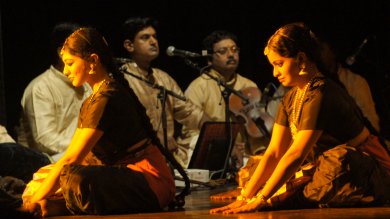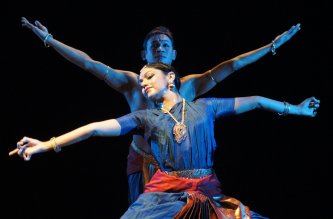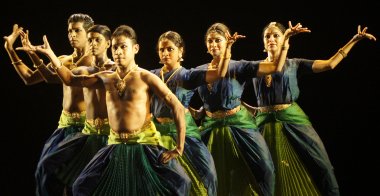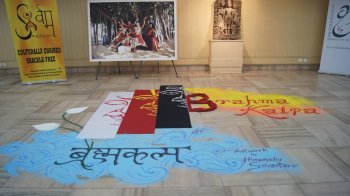
|   |

|   |
Keeping time - Shveta Arora e-mail: shwetananoop@gmail.com Photos: Anoop Arora November 18, 2014 It was a performance perfect to the hilt. Effects, sound, music, choreography, dancers... all were perfect. No wonder Kamani Auditorium in Delhi was full to capacity with a very enthusiastic crowd on the 26th of October, when Brahmakalpa was presented by Rama Vaidyanathan and Ajit Bhaskaran Dass from Malaysia. Rama said, “Brahmakalpa is a unit of time for supreme consciousness or Brahma. I got good Sanskrit text from the Vedas about the subject to translate into dance. I have religiously used the grammar of Bharatanatyam for the pure dance sequences and abhinaya. 

The entire production was divided into four acts. The production was about the origin of the universe and at the same time, drawing parallels with time. Kalpa is an aeon and Brahmakalpa is a day in the life of Brahma. The first piece depicted how a small speck or dot of energy expanded and exploded to form the present universe. This is what has been presented as the Big Bang Theory by modern science. Prakriti Urjaya Mahaaspotavadaha (natural energy exploded). The dancers wore red fans on their costumes for this piece. The footwork and formations were energetic and aesthetic. The music with the kanjira was catchy. The cosmic energy manifests as the sun, Surya Moortay Namastute (salutation to the life giver, sun). The dancers did the Surya Namaskar. Ajit depicted the sun. The earth, which was born subsequently, is seen as the mother to all (Mata Bhoomi Putroham Prithviyaha). Rama depicted the earth. Again, it was the interplay of the music and dance that made the piece captivating. And then, while the sun (Ajit) moves, the earth (Rama in slow movements) revolves around it while rotating on its axis. The sequence left an impact on the audience. Eta utya ushasah ketu makrat poorve rajaso bhanu manjat (The rays of the sun at one time fill only half the globe with light while the other half remains in darkness). Once the srishti or the universe was created, it fell into a rhythm or pattern. Matter can neither be created nor destroyed. What takes birth has to die and then re-emerge. Day and night, good and evil and the seasons, all follow a rhythm. This is an incessant cycle of creation, preservation and dissolution. Srishti, sthiti, laya represented creation, preservation and dissolution. The trinity of Brahma, Vishnu and Shiva are each responsible for these three processes in the universe. Brahma takes the onus of creation, Vishnu preserves and Shiva is the destroyer. The dancers did various formations to depict the three gods. Brahmanaspateya, Bhushapateya, Prajapateya, Vakpateya Namah (this world came into existence from you) - this was a chant for Brahma. Om Namo Vishnavay Prabhavishnavay (The rhythm of the universe is maintained by you). The group depicted the reclining posture of Vishnu on the sheshanaag and the dashavatar of Vishnu through classic postures for each avatar. The chant for Shiva was Samasta Samharaka Tandavaya Namashivaya (The earth evolves because you dissolve to renew). They portrayed Shiva with the damru and agni, the creation of animals, fish, birds, rain, water, flowers, winter and summer. They wore green fans on their costumes for this piece. The high point of this piece was the vocals. Srishti, sthiti, laya were sung as a chant, taking the laya to higher notes. For the next section, the dancers changed into yellow and blue fans on their costumes. The human soul is a part of the Supreme, whose presence can be felt all around us in his creations - the heat within the fire, the scent in the flowers, the gem within the stone, the truth within the word, the mercy within justice, the might behind valour. In fact, without the Supreme, all creation is nothing. So the craving for the union becomes the ultimate goal of all creation. This yearning, sensual as well as spiritual, has sometimes been seen as that between two lovers. Rama and Ajit showed the viraha or the longing. They portrayed the presence of the Omnipresent in the entire creation. For the last piece, Footsteps of Time, the fans and the costumes were striped and colourful. Kaalo ashwo vahati – time runs past us like a swift horse. There is no stopping or controlling of this horse-like time. Kaalo kridati gachhattyaudaha - time plays and life ebbs. The dancers kept running across the stage, making quick entries and exits. The play of time was portrayed by each one of them performing fast-paced nritta with a lot of agility and energy. The movement of time was essayed by the movement of hands like a clock. The performance ended with a recital of chants (Om Tat Sat Ekam Brahma /Om Eim Hrim Shrim Klim Sau Satchit Ekam Brahma) 

In the final formation, one male dancer lifted the other, Dakshina did a leg spilt and Uma bent backwards. It looked something like a watch without its casing, when you see the individual parts of machinery moving uninterrupted. According to Rama, it denoted the fact that time is passing, each one has a different equation with it, and it is up to each to interpret it. Brahmakalpa was choreographed by Rama Vaidyanathan and artistic direction was by Ajit Bhaskaran Dass. Rhythmic compositions and nattuvangam was by Karaikudi Sivakumar, music composition and vocals by Satish Venkatesh, vocal by Vasudevan Iyengar, mridangam by Sumodh and tavil, ganjeera by Mahesh, violin by Viju S Anand, flute by Rajesh Prasanna and lights by Gautam Bhattacharya. The other dancers were Dakshina Vaidyanathan, Uma Govind, Vijayan Veeryan and Pratibhan Sethu. The rangoli in the foyer by Himanshu showed Brahma, Vishnu and Shiva in white, red and black respectively, the fire emanating at one end on the top, and clouds of space below the three faces, showing the universe. The evening was sponsored by Sarvam Foundation, partnered by Kri Foundation. Shveta Arora is a blogger based in Delhi. She writes about cultural events in the capital. |